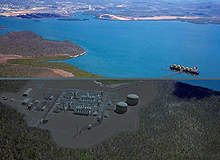
The Gladstone liquefied natural gas (GLNG) project on Gladstone Island in Queensland, Australia, is the world’s first unconventional gas processing plant.
It processes the coal seam gas (CSG) resources of the Bowen and Surat Basins into liquefied natural gas (LNG) for sale in Asian markets.
The plant initially produces 7.8 million tonnes per annum (Mtpa) of LNG. The production will be increased to 10Mtpa in the future.
The A$16bn ($16.98bn) project was developed by Australia’s largest domestic gas producer Santos in joint venture with PETRONAS, Total and KOGAS.
The final investment decision was made by the joint venture partners in January 2011 following the receipt of environmental approval from the federal government in October 2010. The project broke ground in May 2011 and exported first LNG in October 2015.
The GLNG project contributes to the economic development of Queensland by creating 6,000 jobs and generating A$40bn ($42.45bn) of income tax revenues for the federal government. It will also generate more than A$6bn ($6.36bn) of state revenue over a 25-year period and promote exports worth A$9bn ($9.55bn) a year.
Construction and infrastructure of the unconventional gas processing plant
The GLNG project included construction of a 420km-long gas transmission pipeline from Fairview gas field to Gladstone coast, construction of two LNG liquefaction trains at the processing plant and export facilities on Curtis Island, offshore of Gladstone.
The first production from trains 1 and 2 was achieved in September 2015 and March 2016, respectively.
The combined nameplate capacity of the two trains is 7.8Mtpa. The plant utilises the ConocoPhillips Optimized Cascade Process for producing gas.
The project site also features 2,234ha of forest plantation area which has been developed to make beneficial use of the water discharged during CSG extraction.
Partners involved in Gladstone’s liquefied natural gas project
The project was conceived by Santos in July 2007. PETRONAS was signed in as a 40% joint venture partner in May 2008 for an initial consideration of $2bn. The joint venture company is responsible for developing and operating the pipeline and the LNG Plant. It is also responsible for marketing activities in Asia’s largest markets of Japan, Korea and Taiwan.
Santos sold 15% working interest in GLNG to France-based LNG buyer Total in September 2010. PETRONAS simultaneously sold 5% of its share in the project to Total.
Santos and PETRONOS sold 7.5% each of their shares in the GLNG project to Korea-based company KOGAS three months later in December 2010. Santos sold an additional 7.5% interest to Total for an aggregate of A$665m ($705.8m), which was used towards the development of the project.
Santos currently holds the highest working interest of 30% in the GLNG project. PETRONAS and Total have an equal share of 27.5% each and KOGAS has 15% interest.
Supply contracts awarded
Santos had signed A$100bn ($106.1bn) off-take agreements with PETRONAS and Total as of September 2010.
PETRONAS will buy 3.5Mtpa of LNG for 20 years. The volume includes 1.8Mtpa of LNG produced from train one and 1.7Mtpa produced from train two. The off-take agreement signed with Total included supply of 1.5Mtpa of LNG.
It however included a provision in which GLNG could terminate the binding head agreement upon signing of such agreement with another LNG buyer.
The agreement with Total was eventually cancelled when Santos signed a new 20-year off-take agreement with KOGAS in December 2010. The agreement binds Santos to supply 3.5Mtpa of LNG to KOGAS for 20 years. Santos will deliver 1.7Mtpa from train one and 1.8Mtpa from train two. The supply volume of the two off-take agreements is equivalent to approximately 11% of Korea’s and 9% of Malaysia’s domestic need for LNG.
Santos signed a gas purchase agreement with AGL Energy in December 2015 for the supply of 254 petajoules (PJ) of gas to the GLNG project for a period of 11 years, beginning from 2017.
Contractors involved in the GLNG project
The pre-FEED contracts for the GLNG project were awarded to Bechtel and Foster Wheeler in 2008. Bechtel was responsible for the FEED study of ConocoPhillips Optimised Cascade Process, while Foster Wheeler carried out the same for Air Products C3MR Process.
The engineering, procurement and construction (EPC) contract for the liquefaction trains was awarded to Bechtel.
Flour was the EPC contractor for the construction of upstream surface facilities and Saipem, the EPC contractor for the construction of the gas transmission pipeline.
AECOM was responsible for providing environmental consultancy services for the GLNG project.


